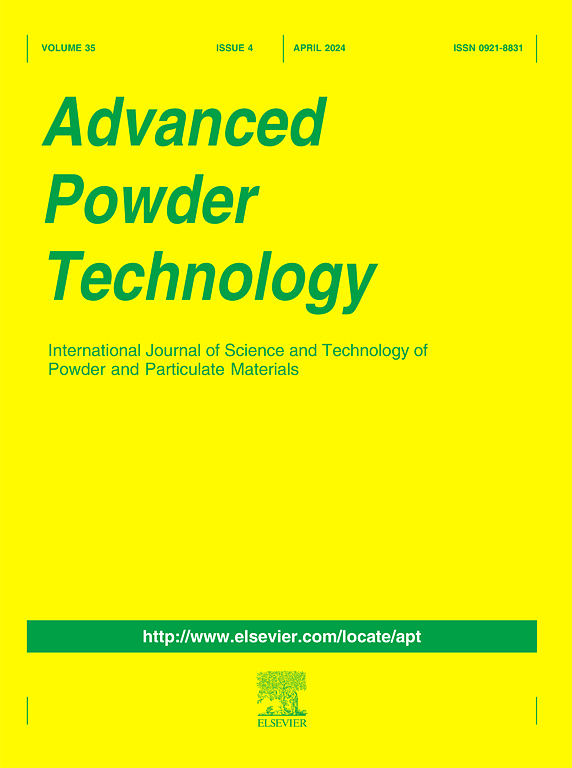Understanding the reaction mechanisms of Mg2B2O5-Fe3O4 and Mg2B2O5-Na2CO3-Fe3O4 systems under different atmospheres
IF 4.2
2区 工程技术
Q2 ENGINEERING, CHEMICAL
引用次数: 0
Abstract
Ludwigite ore is a strategic and characteristic resource characterized by its multi-mineral intergrowth, serving as the primary raw material for the current boron industry in China. However, its comprehensive and efficient utilization presents challenges due to the complex mineralogical composition and mineral associations. Mineral phase reconstruction of ludwigite ore through soda-ash roasting has proven to be an efficient approach for activating and separating boron and iron. Nevertheless, the transformation behavior of boron and iron and physicochemical properties of reaction products are significantly affected by the amount of soda-ash and the roasting atmosphere, and the underlying reaction mechanism remains unclear. In this study, the reaction behaviors of Mg2B2O5-Fe3O4 and Mg2B2O5-Na2CO3-Fe3O4 systems under different roasting atmospheres were investigated to better understand the reaction mechanism involved in the soda-ash roasting of ludwigite ore. The results showed that Fe3O4 was oxidized to Fe2O3 and it hardly reacted with Mg2B2O5, while in the presence of soda-ash, it reacted with Mg2B2O5 to generate NaBO2 and MgO, and then Fe2O3 further reacted with MgO to form MgFe2O4 (air atmosphere). The roasting behavior under nitrogen and weakly reducing atmospheres was found to be similar. In the absence of soda-ash, Fe3O4 showed a slight reaction with Mg2B2O5, resulting in the formation (Mg, Fe)2FeBO5 by solid–solid interfacial reaction. When soda-ash was present, Mg2B2O5 reacted with Na2CO3 to yield NaBO2 and MgO, after which Fe3O4 further reacted with MgO to form MgxFe3-xO4 and MgyFe1-yO via isomorphic substitution.

了解不同气氛下Mg2B2O5-Fe3O4和Mg2B2O5-Na2CO3-Fe3O4体系的反应机理
硼铁矿是一种多矿共生的战略性、特色化资源,是当前中国硼工业的主要原料。然而,由于其复杂的矿物组成和矿物组合,其综合高效利用面临挑战。钠灰焙烧法重建铁硼矿物相是一种有效的活化分离硼铁的方法。然而,硼和铁的转化行为和反应产物的理化性质受钠灰量和焙烧气氛的显著影响,其潜在的反应机理尚不清楚。研究了不同焙烧气氛下Mg2B2O5-Fe3O4体系和Mg2B2O5- na2co3 -Fe3O4体系在不同焙烧气氛下的反应行为,以更好地了解钠灰焙烧过程中所涉及的反应机理。结果表明:Fe3O4被氧化为Fe2O3,与Mg2B2O5几乎不发生反应,而在钠灰存在的情况下,它与Mg2B2O5反应生成NaBO2和MgO,然后Fe2O3进一步与MgO反应生成MgFe2O4(空气气氛)。在氮气和弱还原性气氛下的焙烧行为相似。在无碱条件下,Fe3O4与Mg2B2O5发生轻微反应,通过固-固界面反应生成(Mg, Fe)2FeBO5。当存在纯碱时,Mg2B2O5与Na2CO3反应生成NaBO2和MgO,然后Fe3O4与MgO通过同构取代反应生成MgxFe3-xO4和MgyFe1-yO。
本文章由计算机程序翻译,如有差异,请以英文原文为准。
求助全文
约1分钟内获得全文
求助全文
来源期刊

Advanced Powder Technology
工程技术-工程:化工
CiteScore
9.50
自引率
7.70%
发文量
424
审稿时长
55 days
期刊介绍:
The aim of Advanced Powder Technology is to meet the demand for an international journal that integrates all aspects of science and technology research on powder and particulate materials. The journal fulfills this purpose by publishing original research papers, rapid communications, reviews, and translated articles by prominent researchers worldwide.
The editorial work of Advanced Powder Technology, which was founded as the International Journal of the Society of Powder Technology, Japan, is now shared by distinguished board members, who operate in a unique framework designed to respond to the increasing global demand for articles on not only powder and particles, but also on various materials produced from them.
Advanced Powder Technology covers various areas, but a discussion of powder and particles is required in articles. Topics include: Production of powder and particulate materials in gases and liquids(nanoparticles, fine ceramics, pharmaceuticals, novel functional materials, etc.); Aerosol and colloidal processing; Powder and particle characterization; Dynamics and phenomena; Calculation and simulation (CFD, DEM, Monte Carlo method, population balance, etc.); Measurement and control of powder processes; Particle modification; Comminution; Powder handling and operations (storage, transport, granulation, separation, fluidization, etc.)
 求助内容:
求助内容: 应助结果提醒方式:
应助结果提醒方式:


